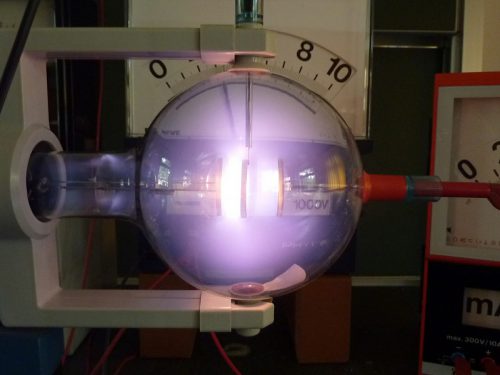The research is part of the photonic quantum processor program at CQC2T. The Center of Excellence is developing parallel approaches using optical processors and silicon processors in the race to develop the first quantum computing system

Scientists have developed a topological photonic chip for quantum information processing, promising a more robust option for scalable quantum computers.
The research team, led by Dr. Alberto Prozzo from RMIT University, demonstrated for the first time that it is possible to code, process and transmit quantum information from a distance using topological circuits on a chip. The research is published in Science Advances.
The breakthrough can lead to the development of new materials, new generation computers and a deeper understanding of the basic sciences.
In collaboration with scientists from Politecnico di Milano and ETH Zurich, the researchers used topological photonics – a rapidly developing field that aims to study the physics of topological phases of matter in an innovative optical context – to build a chip with a "beam splitter" and create a high-precision photonic quantum gate.
"We anticipate that the design of the new chip will open the way to the study of quantum effects in topological materials and to a new era of topologically robust quantum processing in integrated photonics technology," says Prozzo, principal investigator at the ARC Center for Excellence in Quantum Computing and Communication Technologies (CQC2T) and director of the Quantum Photonics Laboratory at -RMIT.
"Topological photonics has the advantage that it does not require strong magnetic fields, and it has the properties of a very high coherence, operation at room temperature and is easy to handle," says Prozzo.
"These are essential requirements for scaling up quantum computers."
Repeating the famous Hong-Ou-Mandel (HOM) experiment—where you take two photons, the ultimate components of light, and create entanglement between them according to the laws of quantum mechanics—the team was able to use the photonic chip to prove, for the first time, that topological states can undergo quantum entanglement with high precision.
HOM entanglement is at the heart of optical quantum computation which is very sensitive to errors. Topologically protected states can add robustness to quantum communication, by reducing noise and defects that are common in quantum technology. This is particularly attractive for optical quantum information processing.
"Previous studies focused on topological photonics using "classical" laser light, which behaves like a classical wave. Here we use single photons, which behave according to quantum mechanics," said lead author Jean-Luc Tambescu, a PhD student at RMIT.
Proving quantum entanglement with high accuracy is a precursor to accurate data transmission using single photons in quantum communication - an essential component of a global quantum network.
"This work brings together the two thriving fields of quantum technology and topological insulators and can lead to the development of new materials, new generation computers and basic sciences" says Prozzo.
The research is part of the photonic quantum processor program at CQC2T. The Center of Excellence is developing parallel approaches using optical processors and silicon processors in the race to develop the first quantum computing system.
Australian CQC2T researchers have created a global lead in quantum information. After developing unique technologies to handle matter and light at the level of individual atoms and photons, the team demonstrated the qubits with the greatest precision and the longest coherence time in the solid state, the quantum memory with the longest lifetime in the world, and the ability to run small-scale algorithms on photonic qubits.
More of the topic in Hayadan:

2 תגובות
Peace
A question about a basic principle of quantum mechanics regarding the possibility of transferring information between conjugated elements such as electrons that are at a very large distance from each other instantaneously by simultaneously measuring the spin direction of the two.
Assuming that it is possible in principle to control the direction of the spin by placing the electron in a magnetic field with a defined direction, it is possible, depending on the time of its measurement and the measurement of its conjugated electron (using clock synchronization at both sites), to transfer controlled coded information immediately.
I would love to hear references
which
Quantum computing is a very important pillar in the progress in the quality of artificial intelligence. There are many skeptics about her abilities today. Quantum computing brings us closer to 15 billion neurons, which is the amount in our brain.
Let's say there are 50 QBIT. It means that there are 2 to the power of 50 parallel operations. This is multiplied by a clock frequency of 3X10^9 operations per second.
We will multiply this in parallel computing. Today the NVIDIA card includes 3584 processors. There isn't one in Quantum, but there will be.
You reach a computational power that multiplies with each QBIT. Of course there is a quantum noise barrier, and you can't just add a QBIT.
What's more, the interlacing is currently done by laser beams and nitrogen cooling - a system that IBM sells.
The next multiplier is that in my estimation about a million teams are researching artificial intelligence in an estimate of only an order of magnitude with an error of 10X up and down, I agree that the advancement of intelligence, and not applied intelligence are researching maybe a few thousand. It remains that our understanding of our understanding is limited today. I agree with that. and the neurons
The artificial ones we use are probably far from the natural neurons. And even more than that a complete systemic insight is missing. But when so many teams are working on it - it's a neural network in itself, a network of scientists.
Even I recently got a computer for such calculations, and I'm still insignificant in the world of machine learning. What I wanted to say is the availability of non-quantum computing to many more people. I get the financing from an applied understanding. the research
Bina's thesis I am doing without funding at this point.